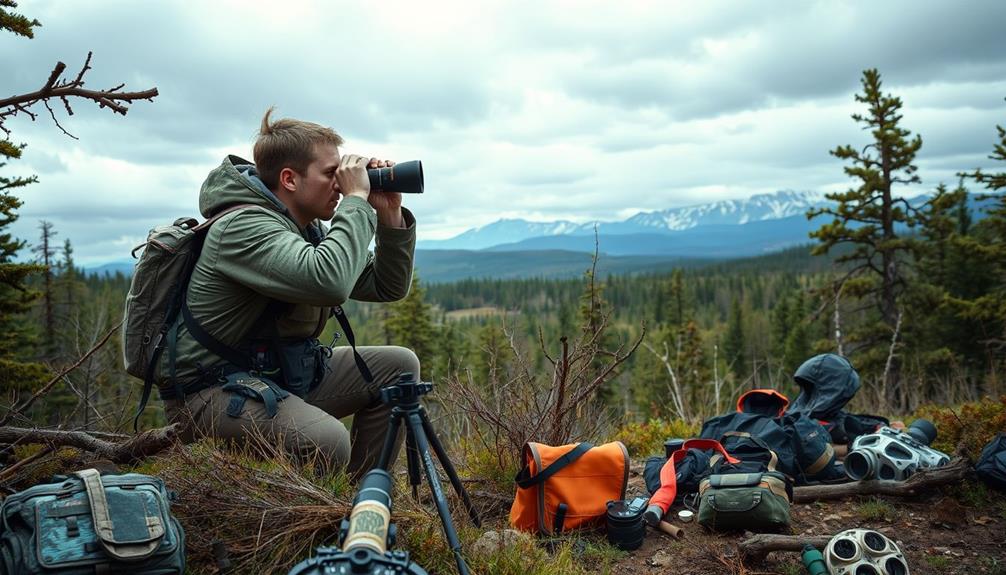Mastering situational awareness is crucial for your safety and preparedness. You need to recognize potential threats by observing your surroundings regularly. Use the OODA Loop: Observe, Orient, Decide, and Act. This process helps you analyze and respond effectively. Enhance your predictive skills by recognizing patterns and trusting your instincts. Don't forget the importance of community involvement; sharing resources and skills can boost overall resilience. Make sure you understand legal considerations as they relate to self-defense and property rights. You're on the right path—continue exploring the essentials, and you'll discover even more ways to enhance your preparedness.
Key Takeaways
- Develop a habit of regular scanning to increase your awareness of surroundings and identify potential threats early.
- Understand and apply the OODA Loop to enhance decision-making in response to observed threats.
- Trust your instincts and evaluate expressions to help gauge intentions and anticipate potential dangers.
- Participate in community workshops and emergency drills to bolster collective safety and preparedness.
- Stay informed about legal considerations related to self-defense and prepping to ensure compliance and peace of mind.
Understanding Situational Awareness

Situational awareness is essential for your personal safety, as it helps you identify potential threats in your environment. It involves being aware of what's happening around you and understanding how those elements may affect your safety.
You'll notice that situational awareness operates on different levels: at the white level, you're unaware of your surroundings; in yellow, you start scanning for threats; at orange, you focus on specific dangers; red means you actively respond to danger, and black can lead to panic, causing confusion.
To enhance your situational awareness, practice regularly observing your surroundings for changes or anomalies. This proactive approach can greatly improve your ability to react effectively and stay safe in any situation.
The OODA Loop Explained

Building on your understanding of situational awareness, the OODA Loop offers a structured approach to decision-making in response to potential threats.
This four-step process—Observe, Orient, Decide, Act—helps you stay focused and effective.
Here's how you can apply it:
- Observe: Gather information about your surroundings. Look for changes or unusual activities.
- Orient: Analyze what you've observed. Assess the potential threats and your environment.
- Decide: Choose a course of action based on your analysis. Consider the best response to the situation.
Enhancing Predictive Skills

Enhancing your predictive skills is essential for effective situational awareness, especially in uncertain environments. By sharpening your ability to recognize patterns and anticipate outcomes, you can stay one step ahead of potential threats. Start by observing behavioral cues in others and noting any unusual trends. Use your past experiences to inform your predictions and trust your instincts in evaluating threats.
| Skill | Action | Outcome |
|---|---|---|
| Recognize patterns | Monitor behaviors | Anticipate threats |
| Evaluate expressions | Analyze emotions | Gauge intentions |
| Reflect on experiences | Review past incidents | Improve responses |
| Regular scanning | Stay alert | Increase awareness |
| Trust your instincts | Make informed choices | Enhance safety |
Importance of Community Involvement

Engaging with your community isn't just beneficial—it's essential for effective prepping. By building a supportive network, you enhance your preparedness and resilience.
Here are three ways community involvement can help:
- Shared Resources: Pooling supplies and skills with neighbors guarantees everyone has access to essential items during emergencies.
- Skill Exchange: Organizing workshops allows you to learn valuable survival skills and share your expertise, creating a more prepared community.
- Emergency Drills: Conducting joint drills fosters teamwork and helps everyone understand their roles in a crisis, reducing panic when real emergencies occur.
Effective Prepping Strategies

Effective prepping strategies are essential for ensuring you and your loved ones are ready for emergencies. Start with a solid plan that includes gathering supplies, practicing skills, and establishing communication methods. Regularly review and update your emergency plans to adapt to changing needs.
Here's a quick reference table to contemplate:
| Strategy | Action Items |
|---|---|
| Supply Basics | Water, food, first aid, tools |
| Skill Development | Self-defense, navigation, fire-building |
| Community Involvement | Local meetups, skill-sharing workshops |
Legal Considerations for Preppers

As you prepare for emergencies, it's vital to reflect on the legal landscape surrounding your prepping activities. Ignoring local laws can lead to unexpected legal troubles, so staying informed is important.
Here are three key areas to review:
- Self-Defense Laws: Understand the self-defense laws in your area to know your rights and responsibilities when it comes to protecting yourself and your property.
- Property Rights: Familiarize yourself with regulations regarding land use, storage of supplies, and any zoning laws that could affect your prepping activities.
- Protection Measures: Be aware of laws governing the tools and supplies you plan to use for protection, ensuring you're compliant to avoid legal issues.
Being proactive about these legal factors will strengthen your preparedness and peace of mind.
Debunking Common Misconceptions

Many preppers hold misconceptions that can hinder their readiness for emergencies. It's important to recognize these myths to enhance your preparedness. For instance, believing that gear alone guarantees safety can lead to overconfidence. Also, thinking community support isn't fundamental can isolate you during crises. Relying solely on stockpiles without adapting to changing scenarios is another common mistake, as flexibility is key in any emergency. Additionally, neglecting versatile tools like the ultimate survival bandanas for preppers can cause you to overlook simple yet practical solutions that bridge multiple survival needs. By addressing these misconceptions, you can build a more comprehensive and effective approach to emergency preparedness.
| Misconception | Reality |
|---|---|
| Gear obsession trumps skills | Skills are essential; gear is secondary |
| You'll prep alone | Community support boosts resilience |
| Panic won't happen to you | Everyone can panic; preparation helps |
| It's too late to start prepping | It's never too late to learn and adapt |
Frequently Asked Questions
How Can I Quickly Assess My Surroundings in a New Area?
To quickly assess your surroundings in a new area, scan for exits, identify potential threats, observe people's behavior, and note any unusual activities. Trust your instincts and stay alert to changes in your environment.
What Are the Best Practices for Maintaining Situational Awareness While Traveling?
When you're on the road, keep your eyes peeled. Stay alert by scanning your surroundings, trusting your instincts, and engaging with locals. Avoid distractions, and remember: a moment of awareness can save you from trouble.
How Do I Train My Mind to Recognize Patterns in Behavior?
To train your mind to recognize patterns in behavior, actively observe your surroundings. Practice identifying unusual actions, and reflect on past experiences. Regularly engage in discussions about behavior to enhance your analytical skills and intuition.
What Tools or Apps Can Assist With Situational Awareness?
To enhance your situational awareness, consider using apps like Situational Awareness Tools, SafeZone, or even basic mapping apps. These tools help you monitor your environment, identify threats, and stay informed about local emergencies.
How Can I Improve My Decision-Making Under Pressure?
To improve your decision-making under pressure, practice the OODA loop: observe your surroundings, orient your thoughts, decide quickly, and act decisively. Regularly train in high-stress situations to enhance your response and confidence.
Conclusion
By mastering situational awareness, you're not just preparing for the unexpected; you're transforming into a guardian of your own safety and that of your community. With the OODA Loop in your toolkit and a keen eye for predictive patterns, you'll navigate threats like a seasoned pro. So immerse yourself in prepping, get involved, and dispel those myths! Remember, in a world where chaos reigns, your vigilance can be the lighthouse guiding others through the storm.










